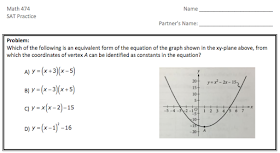In Illinois, we switched from the ACT to the SAT as our standardized test. The math department's digital curricula were originally developed based on the ACT College Readiness Standards, however, we made some changes this summer to also prepare our students for the ACT. You can read more about these changes here.
One of the document templates of our regular math courses was an ACT10. We have one of these documents developed for each skill that we teach our students. The front side of the template presents students with approximately 5 ways that the ACT would question students on the current skill they were learning in class. The back side of the template gives students a mix of 5 ACT-type questions of topics that students have already learned to reenforce their understanding. Here is a sample of an ACT10 that was used in my regular level Algebra I class.
These documents can still be used as warm-up problems and to help students gain an understanding of ACT-style questions, however, the SAT questions are set-up much differently. The ACT focuses on one mathematical skill per question, while the SAT merges multiple skills into a question. Therefore, we need to strengthen our students' critical thinking skills in order to perform better on the SAT.
Therefore, I started brainstorming and came up with a new template. We have been doing a lot of work at Elk Grove High School to find commonalities throughout content areas, so I thought it was fitting to model this template after a science lab report. Students are already accustomed to the process of writing a lab reports, and this format would help break down the SAT question for students.
Here is a sample of this SAT template:






This document helps in two ways: 1) forces students to slow down when solving the problem and 2) gives students who may be lost a place to start. Students who benefit the most from the first way are those that know what to do, but make silly mistakes. The conclusion part of checking their work helps force these students to double check their answers. The students who benefit from the second way are those who defeat themselves before they start the problem. These students may read the problem and immediately give up because they don't know what to do. This step-by-step process helps students to break down the problem to show them that they may know how to do part of the problem. Then, if they can find confidence in understanding part of the problem, they can try to critically solve the rest of it.

No comments:
Post a Comment
Note: Only a member of this blog may post a comment.